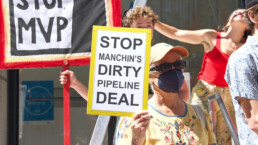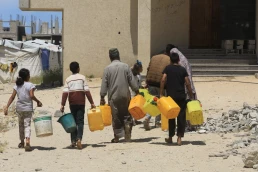The project is over budget and behind schedule, with a lot of hard work left to do. Its opponents hope that makes fossil fuel companies think twice about building the next one.
by Katie Myers, Grist
As day broke over the small mountain town of Elliston, Virginia, one Monday in October, masked figures in thick coats emerged from the woods surrounding a construction site. Three of them approached three excavators and, one by one, locked themselves to the machines, bringing the day’s work to a halt. As they did so, several dozen of their fellow protesters gathered around them, unfurling banners and chanting amid the groaning and beeping of construction equipment.
They made their way across the field, over patches of bare earth, around sections of rusty pipe meant for burial beneath the mountain. Eventually the metal tubes will form yet another section of the Mountain Valley Pipeline, which will soon carry 2 billion cubic feet of fracked methane from the shale fields of West Virginia to North Carolina each day. Their breath billowed in the crisp air. Beyond them stretched a bright blue sky, and mountains tinged with yellow. The past night’s rain pooled on the muddy and compacted soil beneath their feet.

Workers in highlighter-yellow vests and hard hats milled around, some looking amused, others frustrated. One or two engaged with the protesters, only to be told off by an irate site manager. A few miles away at the West Virginia state line, another three dozen or so activists did much the same atop Peters Mountain. One even managed to crawl under an excavator and lock herself in place, despite the cold. The others rallied around, enclosing her in a tight, protective circle.
Some might wonder why they bothered. After all, the project is, by the Mountain Valley Pipeline company’s estimate, 94 percent complete and will be wrapped up before summer. It stalled for several years amid legal fights over various permits, but Senator Joe Manchin, a moderate Democrat from West Virginia, almost single-handedly revived it in 2022 in exchange for his support of key Democratic priorities. Since then, the Biden administration and the Supreme Court have all but assured its completion. With the approximately 303-mile pipeline approaching the final stretch after almost a decade’s work, it might seem hardly worth fighting at this point.
Recent Posts
“Arrest Now, Ask Questions Later”: Why Did L.A. ICE Agents Arrest and Jail U.S. Citizen Andrea Velez?
July 3, 2025
Take Action Now “They didn’t have vests that said ICE or anything. Their cars didn’t have license plates. … Just because of the color of our…
Trump’s Big, Beautiful Bill Is Naked Class War
July 3, 2025
Take Action Now Trump’s “Big, Beautiful Bill” trades tax cuts on millionaires for the dissolution of society.By Hamilton Nolan, In These Times…
Mayor Mamdani’s First Day, A Zero Hour Conversation With Richard Wolff
July 2, 2025
Take Action Now If elected, what would Mayor Mamdani do on his first day in City Hall? How would a democratic socialist govern as a big-city mayor?……
The U.S. Is Funding A Bloodbath At Gaza Aid Centers
July 2, 2025
Take Action Now The admin just gave $30M to GHF, the organization at the center of charges that Israel is weaponizing assistance and shooting at…




